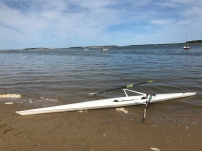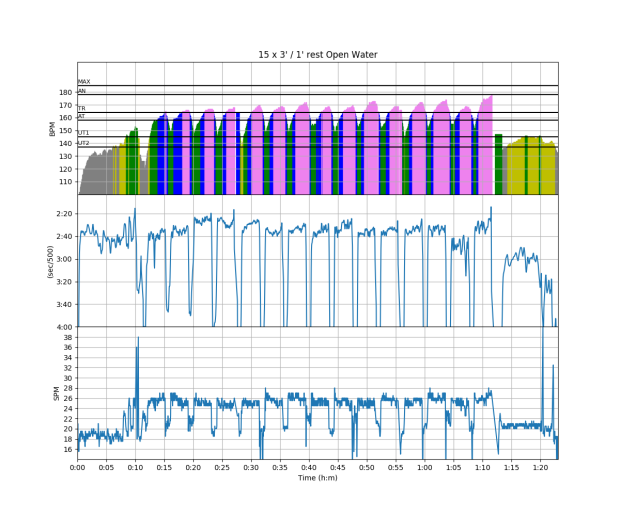The weather is beautiful. 70s, Sunny, brisk breeze from the Southwest, around 15 mph with gusts a bit stronger.
I am trying to do longer rows to get ready for the Blackburn Challenge and I have been trying to get experience rowing in bigger waves. Today’s breeze from the southwest provided a terrific opportunity to do that.
The mission for today was to row up to Wellfleet Harbor and then row all the way to the Red Bell Buoy marking the wreck of the James Longstreet. This was a freighter that was used as a practice naval target during World War 2. The wreck is now almost completely submerged, even at low tide, but the buoy provided a challenging target for today’s row.
Here’s the planned course.

I started at WP0001, which is locally known as kayak beach. I had printed out the chart along with course instructions.

And then taped it in a ziplock bag to the deck beside the cockpit. This worked out well, but I need to work on legibility. I need to make the font bigger and come up with a way to identify waypoints, it was a bit hard to read when the spray was flying!
The actual track shows that I still have a lot to learn about steering in tidal currents.

The first part of the row was slow and careful as I tried to pick my way between the shoals at low tide. It wasn’t as bad as last time, but my oar blades were smooshing into the bottom on a lot of strokes.
I basically rowed straight to the green can, and then turned north to toward the inner harbor. This was delightful downwind rowing. There was a little bit of chop, and it was on my stern quarter. There were some nice surfs along the way.
I got to the end of the breakwater, turned, had a quick drink and started to row against the tide and wind. The first leg, down to a red buoy (WP0004), was good. The waves weren’t that big and I wasn’t really taking on much water. After the Buoy, when I turned to WP0005, I was heading straight into the wind and the building seas. The section from about 7km to 11km was the toughest, slowest, wettest and most challenging rowing of the day.
Once I had the next buoy in sight (WP0005), I turned to the south, and then the wind was on my bow quarter. This was a bit easier and my pace picked up a bit. But as I came out from behind Billingsgate Island, I started to experience the long rolling waves that had built up across all of Cape Cod Bay. These were long period waves, probably 2 feet high, with smaller chop breaking them up a bit. There was a definite pattern of a few big waves, then a lull, then some more big ones. It got a bit hairy as I approached WP0006, my farthest objective. The waves seemed to get steeper over the shallower water here. I was rowing to a compass course until I was able to see the buoy I was rowing for and then I turned straight to it. Here’s a little narrative about my objective from the Embassy Cruise Guide to New England.

I was quite glad to finally get around the buoy, and luckily I did not set off any unexploded bombs. Then I had a long ride back with the waves on my beam and the wind behind me.
This was a different type of challenge, but quite fun. My heading was not far enough downwind to surf the waves. The thing that took some experimenting was figuring out how to deal with radically different water heights beneath each oar. I found it easier with a slightly higher stroke rate.
Heading back, I navigated fine to WP0010, but after that, I maintained the right compass course, but I think the incoming tide pushed me quite a bit off course. I rowed the specified distance from WP0010 to WP0009, but when I looked around, I could find the buoy at all. I tried with and without sunglasses, and completely stopped the boat. Well, that’s not good.
By now, it was a couple of hours after low tide, so I decided to deviate from the planned course and cut the corner to go home. I was getting pretty tired and I had been out for over 2 hours. But this was some of the most fun rowing of the day. The wind and waves were on my port stern quarter, and the wave frequency was long enough that I could surf the front of a wave about every third stroke that I took. When I caught the wave right, the last 3 feet of the stern would be buried and there would be a great swooshing noise from the bow. It took some creative rowing to try to keep the waves from slewing the boat around through the process.
I navigated by eye around the north side of the island and pushed hard as I finished the last leg to Kayak beach. I could barely stand up when I got out of the boat, but I was grinning from ear to ear.
The pace and HR plot below shows how it was tough to row hard when I was going into the wind and waves. It was easier to push when I was surfing.

It was quite a workout. nearly 2 hours of UT1. Total time on the water was 160 minutes.

Workout Summary - media/20170611-171639-Greg Smith 20170611 0844amo.csv
--|Total|-Total-|--Avg--|-Avg-|Avg-|-Avg-|-Max-|-Avg
--|Dist-|-Time--|-Pace--|-Pwr-|SPM-|-HR--|-HR--|-DPS
--|25496|159:57.0|03:08.2|000.0|21.3|148.7|169.0|07.5
W-|25496|159:57.0|03:08.2|000.0|21.3|148.7|169.0|07.5
Below are pace and rate charts. The one from on the left is from the speedcoach. The one on the right from Crewnerd. Speedcoach continues to have some trouble finding the stroke rate in rough seas. But the pace information is a bit smoother.
Tomorrow: Hopefully on the water in Newton.
| M1 |
4 x 15′ / 4′ |
7′ @ 5KP, 8′ @ MP |
92.5% |
(172) |




























































